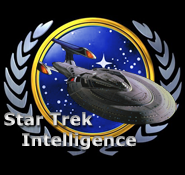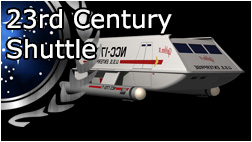Star Trek Intelligence - The best source for Star Trek starships and technology information - Last update: 12.31.2022
Star Trek and all related material are registered trademarks of CBS and Paramount Pictures. All information relating to Star
Trek on the following pages is solely intended for the entertainment of the viewer only. All known information and
image sources have been credited, no copyright infringement is intended. For all issues please contact
Star Trek Intelligence
All st-intelligence.com content, Copyright © 1998-2020 by Star Trek Intelligence [ST-I] and Brandon Bausch.
All rights reserved.

Star Trek Starship and
Technology Database
From:
Starfleet Intelligence Central Records Archive
Subject:
Select Starship and Technology Report
As requested, selected starship and technology intelligence reports transferred from the Central Records Archive
located at Starfleet Intelligence headquarters. Per regulations all information in this document is considered
classified and is not to be shared with individuals without prior clearance.
You may now use this PADD to review intelligence information obtained from the major powers of the galaxy translated
into standard Federation English for your convenience. To review, click the button at the top of your PADD. Further
database structure and usage information can be found in the database guide.
Please select the starship intelligence report of your choice. It should be noted that because of the nature of
intelligence gathering, only a limited amount of information may have been obtained due to an increase in security or
the reassignment or untimely death of one or more undercover agents. However Star Fleet Intelligence is committed to
gather the most complete intelligence possible, no matter the cost.
Star Trek Intelligence 7.0 ... Is now online!
A new redesign and content up to and including the latest seasons of Star Trek! Please check out the Federation startships for the first wave.
Ship Rendering Engine ... Online
Interface Update ... Online
Database Update ... Online
Star Trek Intelligence 6.0 ... Online
Welcome to the new and improved Star Trek Intelligence 6.0. I apologize for the long neglect of the site, after the 'reported'
death of Star Trek. Though with new life, I though it might might be time to also bring the old site back to life for the
enjoyment of all.
Category:
Length:
Width:
Height:
Mass:
Shuttle
7.0 meters
Commisioned:
Phasers:
Cruising Speed:
Max Speed:
Notes: Short range non-warp capable shuttle found on Constitution class starships. A warp capable variant of the shuttle was
also produced for starship to starship operations, designated Type F.

Phasers, or PHASed Energy Rectification, are the primary sub-light weapon used by most advanced space-faring races, most notably the United Federation of Planets, for ship-to-ship and ship-to-ground combat.
The first phasers were designed to replaced primitive EM weapons such has lasers and particle beam accelerators. Phasers and EM weapons both share a common design lineage in practical directed energy devices created for early starship to clear dust and small meteorites from their flight path. Phasers in their current form came into wide spread service during the 2200's, with most Starfleet ships being equipped with them by the 2250's. Today phasers are used on board starships to place a high energy beam on a hostile target's hull in order to damage or destroy the vessel. Phasers can also be configured for multiple non-destructive purposes such as low energy scans or drilling operations.
The energy released by phasers is created by the rapid nadion effect (RNE); nadions are subatomic particles that interact with certain types of superconducting crystals called fushigi-no-umi. When the nadions interact with the crystal, the strong atomic force is freed from the nuclei of the crystals' atoms; the strong force is then transferred to the phaser's output beam.
The basic component of the ship's phasers is the emitter. The phaser emitter is composed of an EPS power system, a prefire chamber, and several emitter crystals to allow discharge in multiple directions. A couple hundred phaser emitters may be arranged linearly to form large phaser arrays.
The phaser emitters are powered by the ships EPS system, when the firing sequence starts, plasma from the EPS conduits is discharged into the plasma distribution manifold. Plasma flows from the manifold to each of the phaser emitters where it enters the prefire chamber. In the prefire chamber the plasma energy undergoes an EM spectrum shift and is released to the emitter crystals to create the RNE effect. Once the energy is discharged from the emitter crystal it flows into the neighboring emitter due to force coupling effects. Energy from each emitter segment converges to a final discharge point where the phaser beam is released. The starship's firing computer can control the direction and power level of the beam emitted by controlling the flow of EPS plasma of each emitter and the direction it is released to the emitter crystal.
Starfleet uses a common phaser array layout for most of its starships. There are two primary large dorsal and ventral arrays wrapped around the saucer section. There may also be numerous smaller phaser arrays on the stardrive section and nacelles. This configuration gives a starship a near 360 degree firing arc in all directions. Most Starfleet ships are equipped with type X phasers which have a maximum power output of 5.1 MW per emitter segment and an effective range of 300,000 kilometers. Phaser recharge time is less the 0.5 seconds with a sustained full power fire time of 45 minutes. New Starfleet ships are now equipped with type XII phasers; performance specifications of these weapons are classified. Older vessels still in service may be equipped with type VII-IX phasers with significantly downgraded specs.
Phasers can be countered by the use of EM shielding on the threat vessels. Depending on technology level a single phaser hit may not be able to penetrate a vessel's shields, but continuous phaser hits should start to weaken the shielding, overwhelming the shield generator power systems. Shields may also be overcome by matching the phaser and shield frequency. A vessel's own shields will not affect phaser fire due to the polarization of the shields.
Recent phaser advance now allow phasers to be used at warp speed by use of a annular confinement beam around the phaser. This prevents dissipation of the phaser energy in the presence of warp fields. Other recent phaser improvements include pulse fire cannons and phaser frequency rotation.





